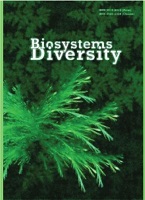Diversity, distribution and conservation status of mangrove species in Pulias Bay, Indonesia
Diversity, distribution and conservation status of mangrove species in Pulias Bay, Indonesia
Author(s): S. Rahim, D. W. K. Baderan, M. S. Hamidun, A. Hasim, W. E. S. Anwar, M. H. Angio, A. Faqih, M. R. Hariri, S. SunardiSubject(s): Agriculture, Energy and Environmental Studies, Environmental interactions
Published by: Дніпропетровський національний університет імені Олеся Гончара
Keywords: Celebes; diversity; mangroves of Teluk Pulias; Shannon-Wiener diversity index; Rhizophoraceae;
Summary/Abstract: As an ecosystem, the mangrove ecosystem serves various purposes. The objectives of this study are to (1) identify the community structure of the important value index; and (2) evaluate the importance of the mangrove species diversity index in Pulias Bay in Ogodeide District, Tolitoli Regency. The study was conducted in 2021 using a quantitative descriptive methodology and survey method. The number of discovered species will be used to establish the species composition. The structure of the mangrove communities is being evaluated by calculating the relative density (RD) and frequency (FR). The data is tabulated to calculate the Important Value Index (IVI) value according to the ShannonWiener formula. There were 18 different species of mangroves discovered, including Rhizophora apiculata, Rh.mucronata, Rh. stylosa, Bruguiera parviflora, B. gymnorrhiza, Ceriops tagal, C. decandra, Sonneratia alba, S. caseolaris, S. ovata, Avicennia lanata, Xylocarpus moluccensis, Acrostichum aureum, Nypa fruticans, and Pemphis acidula. TheRhizophoraceae family predominated at each observation station, according to the findings of the vegetation analysis. Meanwhile the most rarely found species of mangrove were Acrostichum aureum, Sonneratia casiolaris, and Xylocarpus moluccensis, each with two specimens. The community structure reveals that X. moluccensis has the lowest IVI value of 12.7%, while Rhizophora mucronata has an IVI value of 101.3%. The mangrove Diversity Index (H') has a value of 2.48 and meets the standards for moderate diversity. Physical and chemical parameter measurements often indicate that the four stations or sites where the data was collected have similar conditions. Interestingly, we also found Avicennia lanata, a mangrove species that falls under the Vulnerable category. The collected information can be used to manage the mangrove forest in Pulias Bay in the Ogodeide Sub-District of the Tolitoli Regency and serve as a database for efforts to conserve mangroves and mitigate the effects of global warming.
Journal: Biosystems Diversity
- Issue Year: 31/2023
- Issue No: 3
- Page Range: 276-281
- Page Count: 6
- Language: English

